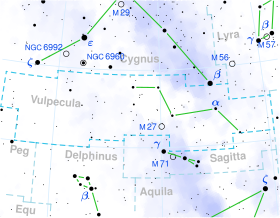29 Vulpeculae
| Observation data Epoch J2000 Equinox J2000 | |
|---|---|
| Constellation | Vulpecula |
| Right ascension | 20h 38m 31.33888s[1] |
| Declination | 21° 12′ 04.2467″[1] |
| Apparent magnitude (V) | 4.82[2] |
| Characteristics | |
| Spectral type | A0V[3] |
| U−B color index | -0.07[2] |
| B−V color index | -0.02[2] |
| Astrometry | |
| Radial velocity (Rv) | -17.10[4] km/s |
| Proper motion (μ) | RA: +74.53 ± 0.76[1] mas/yr Dec.: -0.16 ± 0.69[1] mas/yr |
| Parallax (π) | 14.01 ± 0.99 mas[1] |
| Distance | 230 ± 20 ly (71 ± 5 pc) |
| Absolute magnitude (MV) | 0.56[5] |
| Details | |
| Mass | 2.67[3] M☉ |
| Luminosity | 71[3] L☉ |
| Surface gravity (log g) | 4.20[6] cgs |
| Temperature | 10,507[6] K |
| Metallicity [Fe/H] | -0.15[5] dex |
| Rotational velocity (v sin i) | 52[3] km/s |
| Other designations | |
| Database references | |
| SIMBAD | data |
29 Vulpeculae is a class A0V[3] (white main-sequence) star in the constellation Vulpecula. Its apparent magnitude is 4.82[2] and it is approximately 233 light years away based on parallax.[1] Radial velocity measurements from High Accuracy Radial Velocity Planet Searcher with an amplitude of 4 km/s indicate that it is a spectroscopic binary of unknown period.[7]
References
- ^ a b c d e f Van Leeuwen, F. (2007). "Validation of the new Hipparcos reduction". Astronomy and Astrophysics. 474 (2): 653. arXiv:0708.1752. Bibcode:2007A&A...474..653V. doi:10.1051/0004-6361:20078357. Vizier catalog entry
- ^ a b c d Ducati, J. R. (2002). "VizieR Online Data Catalog: Catalogue of Stellar Photometry in Johnson's 11-color system". CDS/ADC Collection of Electronic Catalogues. 2237. Bibcode:2002yCat.2237....0D.
- ^ a b c d e Zorec, J.; Royer, F. (2012). "Rotational velocities of A-type stars". Astronomy & Astrophysics. 537: A120. arXiv:1201.2052. Bibcode:2012A&A...537A.120Z. doi:10.1051/0004-6361/201117691. Vizier catalog entry
- ^ Gontcharov, G. A. (2006). "Pulkovo Compilation of Radial Velocities for 35 495 Hipparcos stars in a common system". Astronomy Letters. 32 (11): 759. arXiv:1606.08053. Bibcode:2006AstL...32..759G. doi:10.1134/S1063773706110065.
- ^ a b Anderson, E.; Francis, Ch. (2012). "XHIP: An extended hipparcos compilation". Astronomy Letters. 38 (5): 331. arXiv:1108.4971. Bibcode:2012AstL...38..331A. doi:10.1134/S1063773712050015. Vizier catalog entry
- ^ a b David, Trevor J.; Hillenbrand, Lynne A. (2015). "The Ages of Early-Type Stars: Strömgren Photometric Methods Calibrated, Validated, Tested, and Applied to Hosts and Prospective Hosts of Directly Imaged Exoplanets". The Astrophysical Journal. 804 (2): 146. arXiv:1501.03154. Bibcode:2015ApJ...804..146D. doi:10.1088/0004-637X/804/2/146. Vizier catalog entry
- ^ Borgniet, S.; Lagrange, A.-M.; Meunier, N.; Galland, F. (2017). "Extrasolar planets and brown dwarfs around AF-type stars". Astronomy and Astrophysics. 599. A57. arXiv:1608.08257. Bibcode:2017A&A...599A..57B. doi:10.1051/0004-6361/201628805.

